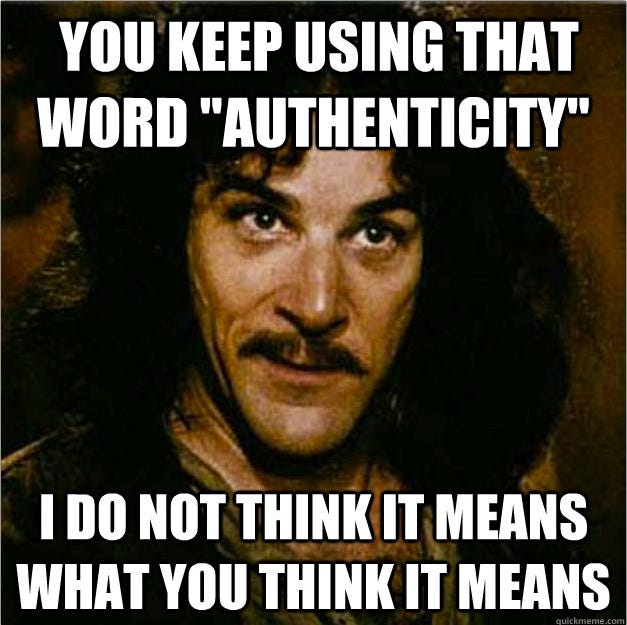How to Share a Withhold
Clear conflicts before they explode.
Sometimes, I get angry with people and think they’re wrong.
I know, shocking. As a communications teacher I should be immune to such emotions. But we tend to teach the things we’re bad at. And I am a sensitive, cranky human.
For a long time I swung between two sides of the spectrum. On one end, I assumed I needed to set aside my judgments and frustrations, when I felt them, and practice dealing with my own feelings about what other people did. I wouldn’t let myself share the frustrations because they were more about me than the other person. They weren’t responsible for my sensitivities. Why should I make them feel bad by sharing?
This led to me distancing from a lot of people. The frustrations didn’t really go away, and because I wasn’t sharing them, I didn’t assume they could.
At the other end of the spectrum, especially when I got involved in Authentic Relating and communications work, I started sharing All The Things whenever I felt them. If something came up, it was my duty to the relationship to share it. Did you leave the dishes in the sink? Time for a Conversation. Did you blow your nose in my general direction? Let’s sit down and Talk.
This approach led to people around me being overwhelmed with processing, and us spending a lot of time looking at our collective navels.
As time has gone on, I’ve found a bridge between these. The bridge is made up of two flexible practices that can help us clear conflicts at any time, except in the middle of an argument. These are not mid-fight techniques. They are structures to set up in advance and then follow to the end - where, almost always, cleaner and clearer connection awaits.
The first of these structures, and the most flexible, is called a Withhold.
Finding Withholds
A withhold is something I am holding back from you that is keeping us from connection. Many organizations and relationships have a term for these, because sharing them is so important to creating team health. A grocery co-op we worked with called them “Go Directs”. A nonprofit we partner with calls them “Rule 0”.
Withholds are the pernicious cracks in the windshield of our relationship, which if left unchecked will leave us with shattered glass in our emotions and a large bill for repair. If we can point these out and patch them up before things break, we’re a lot better off.
To share a withhold, you first need to recognize that you have one. The best way I’ve found to do this is to ask myself:
Who am I avoiding?
Who am I complaining about to myself or others?
I’ll give an example. A few weeks ago, I noticed myself being annoyed at one of my co-workers. I’d asked her to work on a project with me and she’d said she would do it, but hadn’t built the system that would allow us to move the project forward. She hadn’t even set up task tracking for it.
This miss combined in my mind with a lot of other small things that hadn’t been working in our relationship, until I convinced myself there was no other way forward - we’d have to fire her. She just wasn’t doing her job.
At this point, luckily, my husband and collaborator Geof stepped in and said, “Maybe we should…you know…talk to her about it?” I decided to go along with this crazy idea, and we set up the second of the two structures in this video: the Clearing Conversation.
Clearing Conversations
A clearing conversation is your way in to sharing a withhold, or many withholds. We have other words for this when it involves a third party: relationship therapy or mediation. But, in recent shocking news, you don’t actually need to pay someone to have these conversations. You can try setting the context yourself for a conversation, and see if changing the frame changes the way you relate to each other within it.
My favorite way to do a clearing conversation is to message the person or persons I want to have one with, as we did with our co-worker, and say: “Hey. I have some things I want to share that have made me pull away from you a bit, and I don’t want that. Would you be open to setting up a conversation?”
The point of this framing is to share what you want - for instance, to be closer, or not to pull away - without sharing any content. You don’t want to get into the argument then and there. So resist your urge to over-context.
If they say yes, ask about a good time to have the conversation.
When you’re in the clearing conversation, now you can share - wait for it - withholds.
How to Hold a Clearing Conversation
The way I prefer setting this up is:
Each check in with how you’re feeling
Share what you’d like to get out of the conversation. For instance “I want to clear up some issues in our working relationship.”
Give each of you a specific period of time to share. It’s going to feel weird, but it can be really good to use a timer here. Around 7-10 minutes per person is usually enough, with the option to extend if everyone consents. The sharer doesn’t have to talk for the whole time - they can just say a few things and then get questions or reflections from you - but until the timer goes off or they say they’re done, the attention stays on them. It can be good to each bring a notepad where you can write down thoughts or arguments you have while others talk, so you don’t just blurt them out.
In your sharing, consider using the frame of a withhold. The way we do this is by using the phrase,
“___(person’s name), when you ____ (identify a particular, unarguable moment or experience), I felt ___(share an emotion), and the effect was ___(practical or relational outcome that was affected).”
You can then expand on your concerns: why that moment or feeling mattered to you, what you might have preferred instead. The other person can ask questions or reflect.
Then it’s the other person’s turn to share withholds, or explain their perspective. Repeat for all participants
After that, you’ll usually have enough new context on what’s been happening for each of you that you can brainstorm some solutions pretty easily. If you find you’re still getting stuck, see if there are any more feelings or concerns that you want to share. Sometimes, you just haven’t gone deep enough to clear the root of the issue. If you’re having the same argument after many clearing conversations, then it might be time to get a third party. Or, take the Art of Difficult Conversations.
Whichever route you go, always try to end the conversation with some appreciations for each other.
This probably sounds like a restrictive format, so let me show you what it looks like in practice.
Fighting IRL
Let’s go back to the conflict I was having with my co-worker. Since this was a business conflict, as the co-company leads, Geof and I both joined the conversation.
Once on Zoom, we checked in with how we were feeling and what we wanted. We all wanted some version of working better and more effectively together.
We shared a few appreciations about working together, to start off. Then I got time to share my withholds.
I said, “When you took on this project, I expected that you were going to set up a tracking system, because that’s what we discussed. When you didn’t, I felt confused, frustrated, and let down. [The effect was that] I didn’t know how to move forwards, and the project, which is pretty important to us, is standing still.”
After some questions, it was her turn to respond. She said, “Honestly? I’m not great at creating systems. I’m pretty good at using them when they’re set up. It’s part of the job, though, so I feel like I should be able to do it, and you won’t want to work with me if I can’t. So I kept putting it off.”
That was a lightbulb moment for me. She understood why I’d been frustrated, and I now understood why she hadn’t done the work. The best part was - I didn’t need her to set up the system! I love creating systems and I hate maintaining them.
Sharing created its own solution. With my co-worker’s input, I’m now building the system for that project. She’ll be the one to carry it forward. Since that conversation we’re working a lot better together, and we’re both finding feedback easier to share now that we’ve knocked down that first wall.
Withholds, in the format of “When you…I felt…and the effect was…”, can be shared anytime as long as you get consent. You don’t have to set up a clearing conversation to have them. You can turn to your partner while you’re driving to dinner and say “hey, I have a withhold for you, is now a good time to share it?” If you get a no or if your partner generally has trouble with boundaries, you might say “when is a good time to share it?”
You share your withhold, they respond; congratulations: you’ve increased your relational health!
Sharing withholds regularly, before they build up, is the best way I know to maintain relational health in a company, community, or relationship. It opens the space for continuous honesty, instead of bleeding the unsaid at the very end when it can no longer be resolved.
At first, this may seem about as fun as going to the dentist. But it saves about as much future time, money, and pain as cleaning your teeth regularly versus getting cavities.
If you have a bigger withhold, or you’ve been letting them build up for a while, it can be good to set up a clearing conversation so you have more time to share. I personally like having a regular, recurring time on the calendar for each of my important relationships to share withholds and appreciations. Geof and I call ours “Judgment Day.”
Okay, I call it that.
Whatever you call your practice, I suggest making this your regular relationship yoga. Have clearing conversations, share withholds, end with appreciations. An few minutes of this kind of talk can save you years of conflict, or disrupt fights that have been going on for years. The right context makes all the difference.
Your Loving Thought-Dom,
Sara Ness
P.S. This article is actually a script I wrote for a new course we’re filming, which is an on-demand version of our popular Art of Difficult Conversations course. It will have tons of content on 30+ topics and techniques like the above, plus - even more exciting - demos of real people practicing the skills during fights.
There is a waitlist for the course about halfway down this page: https://www.authrev.org/conflict





